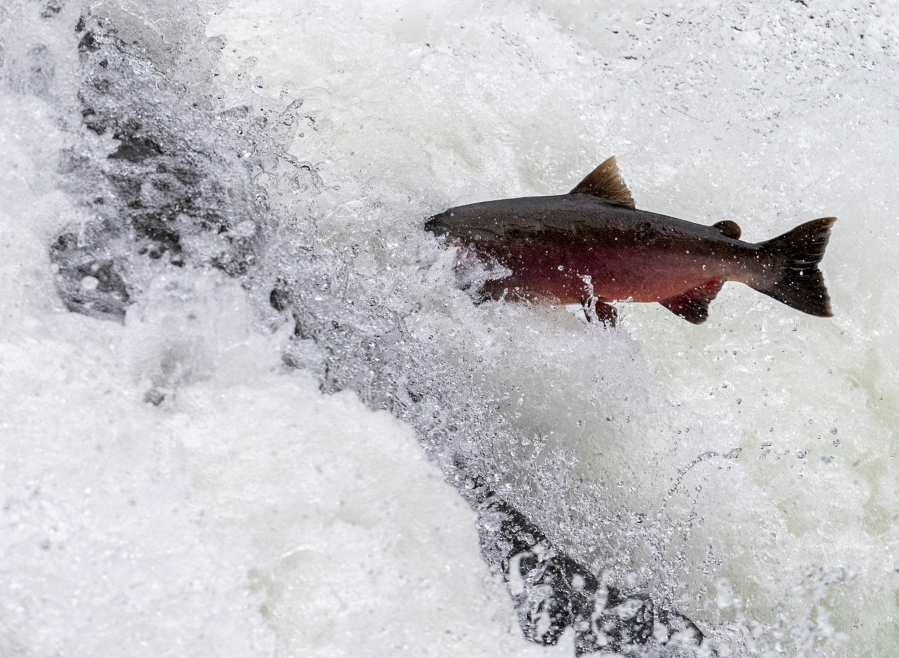BELLINGHAM — Gov. Jay Inslee wants to invest $187 million in salmon recovery as part of his 2022 budget and policy proposals.
The governor unveiled his salmon proposals on Tuesday at the Swinomish Indian Tribal Community reservation’s Swadabs Park.
Inslee announced proposed legislation that would set new standards for salmon habitat protection and conservation efforts. It is called the Lorraine Loomis Act, in honor of the prominent Swinomish tribal elder and salmon advocate who died this summer. Inslee said the legislation is the result of two years of discussions with the state’s tribes.
“Our fight is simple: to be able to practice our culture and feed our spirit with the foods we are accustomed to,” said Kim Murphy, Loomis’ daughter, in a speech on Tuesday.
Salmon are an incredibly important resource to Pacific Northwest tribes, many of which are guaranteed the right to fish, hunt and gather in all of their traditional places through treaty rights.
Tuesday’s event comes a day after a similar unveiling in Olympia on Monday, Dec. 13, at which the governor announced a proposed $626 million for climate action. Inslee will release his full 2022 budget proposal on Thursday, Dec. 16.
Inslee’s plan takes a multi-pronged approach to salmon recovery.
The proposed investments include $123 million in new protections for salmon riparian habitat along the banks of rivers and streams and more than $16 million for water quality and temperature improvements. He also wants to invest $5 million in green infrastructure grants for projects that store water during high flows and release it during low flows, as well as $6.5 million to improve science and monitoring.
A 25-page document outlines some of the specifics of Inslee’s plan, which include establishing a permanent source to fully fund salmon recovery.
More fish passage barriers, such as culverts, need to be removed, Inslee said, and salmon need to be reintroduced to their historic habitat above areas blocked by barriers such as dams and bridges.
The plan also includes goals to integrate salmon recovery with hatchery and hydropower operations.
Federal dollars are coming Washington’s way — the recently passed bipartisan infrastructure law includes billions of dollars for nationwide salmon recovery efforts, and there could be billions more in the Build Back Better Act.
“I commend Governor Inslee for his leadership in supporting the Pacific Northwest’s vital salmon populations, and I am going to make sure the federal government is doing its part to recover our iconic salmon runs,” said U.S. Senator Patty Murray, a Washington Democrat, in a Dec. 14 statement.
These efforts are more crucial than ever now, tribal leaders said Tuesday.
Salmon populations are struggling: Over 70 percent of endangered or threatened salmon and steelhead trout populations are “not keeping pace” with recovery goals or are “in crisis,” according to the 2020 State of Salmon in Watersheds report. Salmon are losing more habitat than they are gaining, Inslee said.
“We are running out of time,” said Willy Frank III, chairman of the Nisqually Tribal Council, at Tuesday’s event. “I think we are past the point of emergency now when it comes to salmon habitat and clean water.”
The report found that a lack of funding is a fundamental reason for continually suffering salmon populations. A 2011 study found that regional salmon recovery plans needed $4.7 billion in funding between 2010 and 2019. As of 2020, only 22 percent of that, or $1 billion, has been invested in salmon restoration efforts.
Climate change is putting added pressure on salmon populations by warming waters and lowering summer river flows.
“The health of the salmon is a reflection on our own wellbeing,” said state Senator Christine Rolfes at Tuesday’s event. “Their success is our success.”
Tribal and environmental leaders hailed Inslee’s proposed plan, but they stressed the need for a continued sense of urgency and unity in the face of declining salmon populations.
“Who would we be without salmon?” said Alyssa Macy, CEO of the nonprofit Washington Environmental Council and a citizen of the Confederated Tribes of Warm Springs in Oregon.
“Are we willing to take the risk to find out the answer to that question, the risk that falls onto the shoulders of the Indigenous people of this state?” she said.
Macy said that the future for salmon looks “grim” and urged Washingtonians to contact their legislators and ask them to support Inslee’s salmon recovery proposals.



